Pad thai may have all the fame, but Thai food lovers know that pad see ew is where real noodle bliss is at. This recipe has been a Hot Thai Kitchen classic for over a decade. It is tried and true, and I promise it'll rival anything you've had in restaurants! It's a quick and simple dish, but you need to know some tricks to achieve perfectly seasoned, not-broken rice noodles with that smokey wok char. Let's dive in!
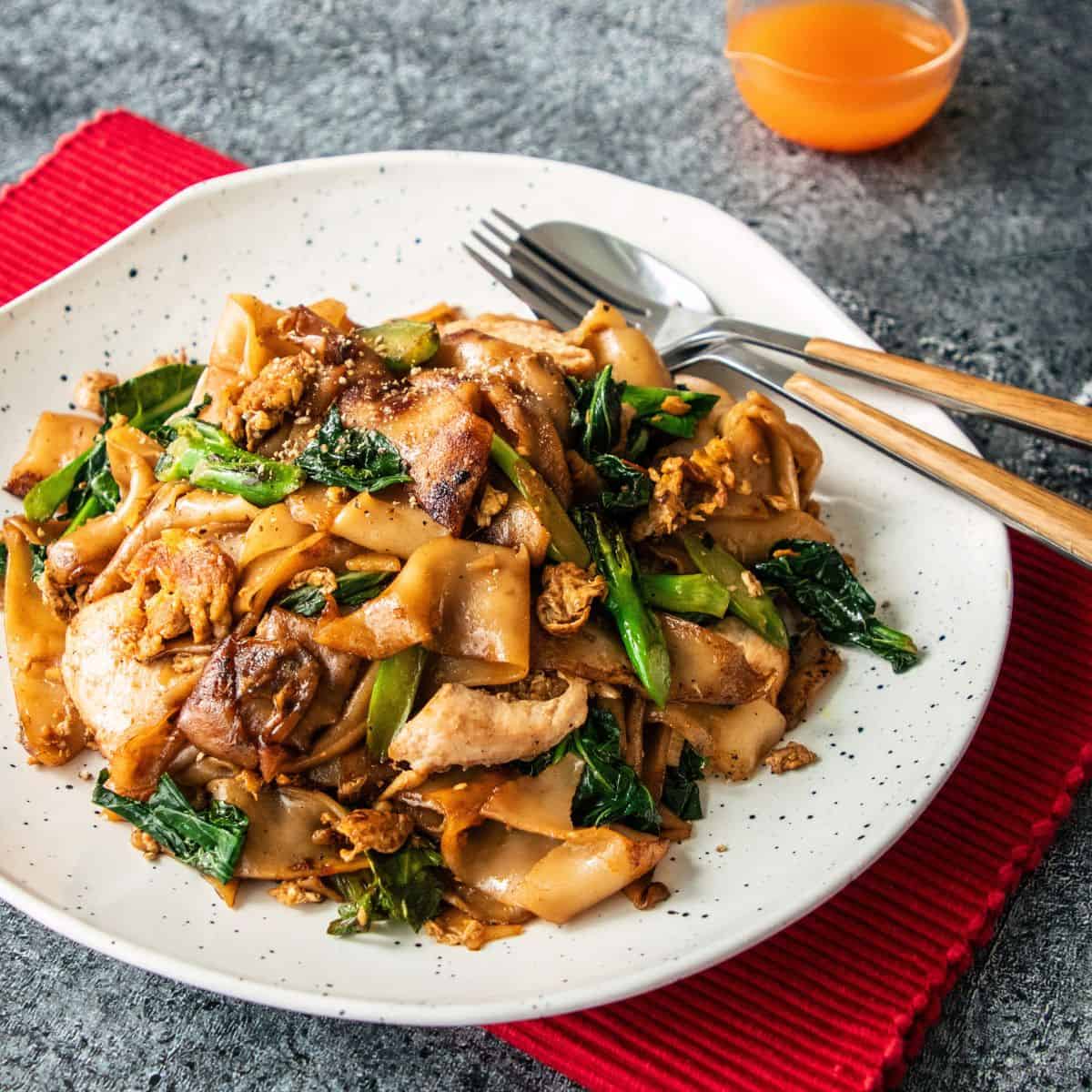
Jump to:
- What is Pad See Ew?
- Ingredients
- Watch The Video Tutorial
- How to Make Pad See Ew
- Common Pad See Ew Problems and How to Avoid Them
- How to Use Dry Rice Noodles Instead
- The best way to keep leftover pad see ew is...to freeze??
- How to Freeze and Reheat Pad See Ew
- Frequently Asked Questions
- More Thai Stir-Fried Noodle Recipes
- Authentic Thai Pad See Ew ผัดซีอิ้ว
What is Pad See Ew?
In Thai, pad means to stir fry and see ew means soy sauce, so...soy sauce stir fry? The unspoken word is guay tiew or "noodles," so it's full name is guay tiew pad see ew. It's a popular Thai stir-fried noodles that you can find all over Thailand, but it has its roots in Chinese cuisine which came to Thailand with the millions of Chinese immigrants.
It's a homey dish of fresh rice noodles seasoned primarily with soy sauce, and stir fried in a hot wok along with slices of meat and Chinese broccoli. In Thailand, pad see ew is a quick solo lunch, so you often find it sold at food courts and by street vendors. They're kind of like the sandwiches of Thai cuisine!
Ingredients
Pad see ew ingredients are short and simple, but using the right noodles and the right sauces are key.

- Fresh wide rice noodles. These tender chewy rice noodles are what make dishes like pad see ew and drunken noodles (pad kee mao) so lovable. These are called sen yai in Thai, but they are also often referred to by their Cantonese name, ho fun. You can buy these at some Asian grocery stores, usually in big cities, in the refrigerated section.
If you can't find them, don't worry, homemade rice noodles are better anyway! Dried wide rice noodles do exist and can be used if necessary, but they are quite different and not nearly as good as the fresh ones. - Protein of your choice, thinly sliced. This can be chicken, pork, beef, tofu, or seafood such as shrimp. In Thailand, pork is the most common.
- Soy sauce for marinating the meat, omit if using shrimp which do not need to be marinated.
- Vegetable oil or another neutral oil of your choice
- Garlic, chopped
- Eggs
- Chinese broccoli, also known as gai lan. Choose smaller stalks if you can as they are more tender and are less likely to be bitter. If you cannot find gai lan, broccolini is a good substitute. I don't suggest using bok choy as it is much more watery and lacks the crunchiness of gai lan stems.
- Sugar. White sugar is fine, but brown sugar will also work.
- Ground white pepper, to taste. This is a common condiment to pad see ew, and the aroma of ground white pepper on top of pad see ew is truly iconic!
- Prik nam som, Thai-style chili vinegar that is a classic condiment that I highly recommend. Pad see ew is sweet and salty, and drizzling a little spicy vinegar really brightens the dish and makes a more balanced flavour. It can be as simple as blending chilies and vinegar, but there are variations which I talk about in my prik nam som recipe here.
Pad See Ew Sauce Ingredients
A good sauce it key to great pad see ew flavour, so I suggest measuring ingredients properly and not eyeballing this one!
- Oyster sauce. Check out my post for how to choose a good oyster sauce. To make a vegan version, use "vegetarian stir fry sauce" or another vegan oyster sauce option.
- Soy sauce. Use Thai soy sauce (Healthy Boy Brand) if you can for the right flavour, but otherwise regular soy sauce such as kikkoman, or Chinese light soy sauce will also do.
- Fish sauce. See this post on choosing a good fish sauce.
- Golden Mountain Sauce. This is a type of Thai soy sauce with a flavour that is slightly richer than the Thai soy sauce. Maggi Seasoning would be a good substitute that tastes similar to Golden Mountain. You can also substitute an equal amount of regular soy sauce.
- Thai black soy sauce. This gives pad see ew its characteristic dark brown colour and a rich flavour. Thai black soy sauce isn't very salty and tends to be a little sweet. If not available, you can sub Chinese dark soy sauce, but because Chinese dark soy is much saltier, you'll need to reduce other sources of salt. The easiest way, in my opinion, is to simply omit the Golden Mountain Sauce.
Watch The Video Tutorial
All my recipes come with video tutorial to ensure success. If you've never made pad see ew before, I highly recommend watching the video first as this dish goes fast, and you'll need to know exactly what to do once the heat is on!
How to Make Pad See Ew
If it's your first time, I highly recommend watching the video tutorial to ensure success. The cooking goes fast, so it's good to know exactly what you need to do before you turn the heat on.
Most important tip: Cook 1 portion at a time to prevent mushy, broken noodles, and to maximize noodle charring. There's a reason street vendors do it this way! (The meat, however, can be cooked all together.)

- If using chicken, pork, or beef, marinate the meat with soy sauce and a bit of sugar. If your meat is lean, like chicken breast of pork loin, you can add about 2 teaspoons of water to give it extra juiciness. Stir to mix well and let sit while you prep other things.
- Combine all sauce ingredients together and stir to mix.
- Cut thicker part of the stems of chinese broccoli into thin slices on a diagonal. Roughly chop thinner stems and leaves.
- Heat the oil in a well-seasoned wok or a large cast-iron skillet over high heat. Once very hot, add all of the protein and spread it out into a single layer as much as possible. Let the protein sear without moving until the underside is browned and the meat is at least halfway cooked.

- Once the meat is browned, toss until the meat is fully cooked. Remove from pan and set aside. If there is meat juices left in the wok, wipe it with a paper towel.
- From this step onward, I recommend cooking 1 portion at a time for best results, so before cooking, divide up your ingredients into single portions. Heat the wok over medium high heat then add a little oil and 1 portion of the garlic; sauté until the smallest bits of garlic starts to turn golden.
- Add 1 egg and scramble briefly.
- Add 1 portion of the Chinese broccoli and toss to coat it evenly in the oil, about 10–15 seconds.

- Add 1 portion of the noodles (8oz/225g), 1 portion of the sauce (2 tablespoon + 1 tsp/35 ml) , and 2 teaspoon (10 ml) of sugar. Turn the heat up to high and toss to coat the noodles evenly in the sauce.
- Spread the noodles out and let them sit without stirring for about 15-30 seconds until some of the noodles have charred on the underside.
- Flip or toss the noodles and let them sit again to further toast the noodles. Repeat the tossing and toasting 1-2 more times.
- Add 1 portion of the cooked protein back in without adding any meat juices that has accumulated in the bowl, and toss briefly to mix. Plate and enjoy with white pepper and chili vinegar.
Common Pad See Ew Problems and How to Avoid Them
After many years of teaching this recipe, I've noticed there are a few things that commonly trip people up. Read these carefully to avoid the same problem!
- Broken noodles. Assuming you're cooking 1 portion at a time as recommended, you're likely stirring too aggressively. Fresh noodles are very delicate, so you want to flip and toss gently, pushing noodles around from the edges rather than haphazardly stirring. Also avoid metal spatula as they can cut noodles more easily.
- Mushy noodles. You might be crowding the pan and trapping too much moisture, which overcooks the noodles and/or your heat is too low. I stress that you should cook one portion at a time to prevent trapping too much moisture under a big pile of noodles. Remember these noodles are already fully cooked, so it doesn't take much additional moisture for them to become over cooked and mushy!
- They don't taste right. Did you eyeball ingredients? Did you measure everything? Pad see ew is one of those dishes where the ratio between sauce and noodles is everything. Unlike meat-and-veggie stir fries, these noodles absorb ALL of the sauce you give them, so if there's too much, it'll be too salty, and if there's too little, it'll be bland...so measuring is crucial!
- Noodles stuck to the pan. Fresh rice noodles love to stick. Make sure your wok or skillet is well seasoned. You can use a nonstick pan but those typically should not be heated over high heat so the noodles may not get a good char.
- There is no wok hei. Wok hei is that smoky wok flavour that many people consider a key ingredient of a good pad see ew. To get wok hei, you need a carbon steel wok on very high heat so the noodles can char and the oil can smoke. Not crowding the pan is also key. Sometimes, this just isn't possible to create given our home equipment, but I think it's still good without it!
Want to save this recipe?
How to Use Dry Rice Noodles Instead
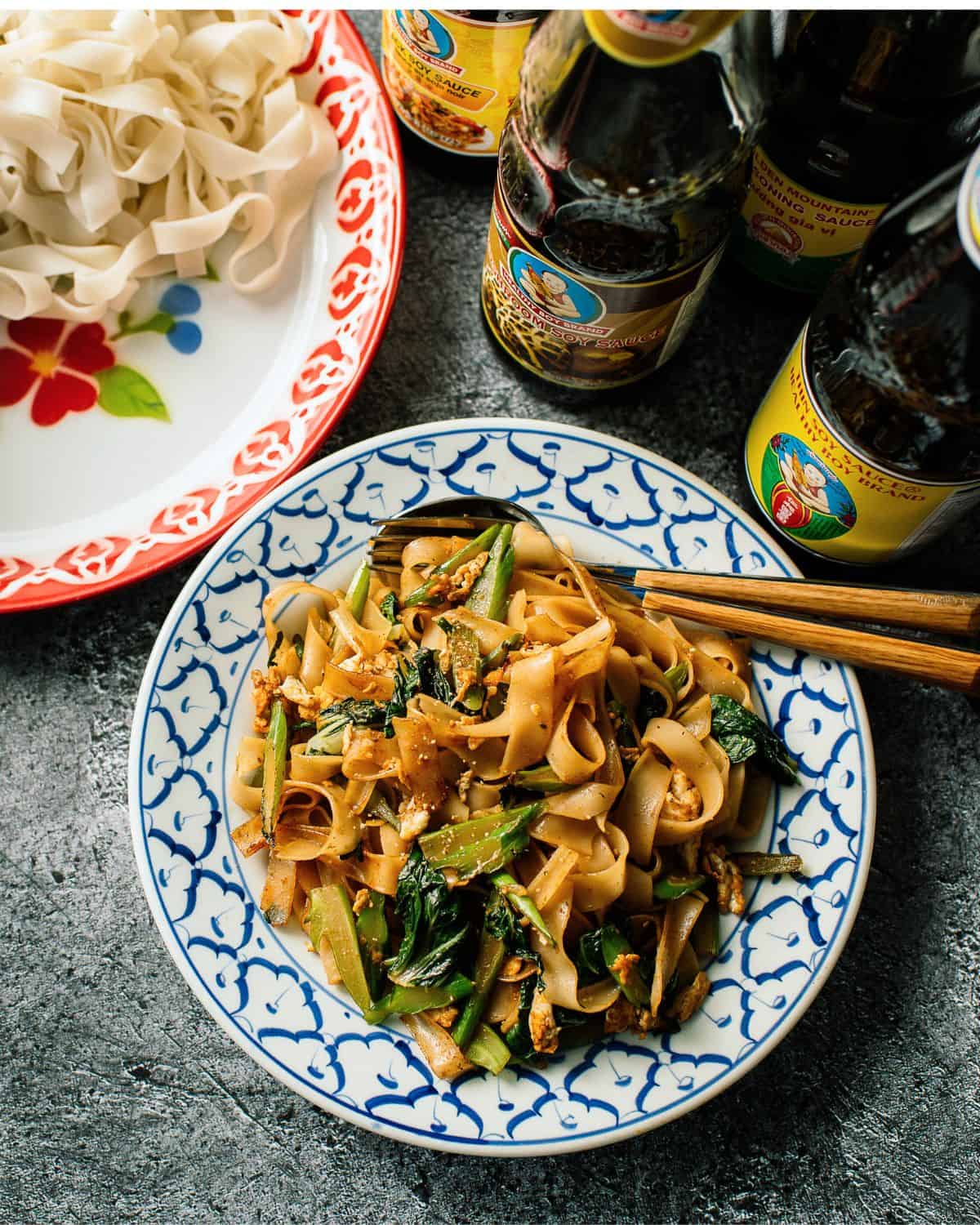
I'll be honest...pad see ew made with dried noodles is not nearly as good as fresh. They have a totally different texture and flavour. I much prefer fresh, and once you experience the wonderfulness of fresh rice noodles... you kinda can't go back.
With that caveat, I understand that in desperate times, sometimes you just gotta get some kind of pad see ew on the table. So if needed: Don't follow package instructions for cooking the noodles, those can be unreliable. Here's what to do:
Soak the noodles in hot off the boil water for 15 minutes, then drain and rinse under cold water. The noodles are now partially cooked and ready to go into the wok, and they will finish cooking in the wok. You will need about 10 oz (280 g) of dried noodles to get 1 lb (450 g) of soaked noodles, but do weigh the noodles again after soaking just to make sure.
When cooking, I suggest tasting the noodles when you think they're done, and if they're still a little too firm, add a splash of water and keep cooking for another minute.
The best way to keep leftover pad see ew is...to freeze??
Yes! But first let me say that pad see ew, like all rice noodle dishes, is best consumed fresh off the stove. That is how you will get the best soft-chewy noodle texture with crunchy veg. So the best thing to do is to not make anymore than you can eat in one meal.
However, sometimes leftovers are inevitable, and you might be surprised that the best way to store pad see ew is to FREEZE it. Yes! This is because if you refrigerate them, the noodles will continue to absorb moisture from the meat and veggies, and eventually become soft and mushy. One day in the fridge, reheated pad see ew noodles will be noticeably less chewy, but 2 days in the fridge and they're basically inedible by my standard.
When you freeze them, however, this moisture absorption does not happen, so when you reheat, the noodles will still maintain their chewiness to a surprising degree, albeit slightly less so than when fresh. And of course the veggie stems will no longer be crunchy, but that's the price you have to pay.
How to Freeze and Reheat Pad See Ew
Freeze pad see ew in a microwaveable container in single portions, so you can reheat it directly. It will not be possible to divide the noodles while it is frozen. I keep mine in a glass food storage container.
Microwave it uncovered or loosely covered so the noodles don't steam, on full power, and do not stir it until most of the noodles have become hot and soft. When noodles are partially thawed they are brittle, so if you try to stir it mid-way you may break the noodles. Once most of them are soft, you can gently toss and bring the middle part out to the edges to get more even heating. Keep microwaving until the noodles are fully heated through and are piping hot. They will not regain their texture until they're piping hot again.
Frequently Asked Questions
Yes! While I do believe that the best version is this classic one made with fresh rice noodles, In Thailand we actually make pad see ew with a couple other different noodles. A common one is sen mee pad see ew made with rice vermicelli. In Southern Thailand I grew up eating pad see ew with egg noodles which is also very good.
Some have asked if pad thai noodles can be used instead, and while it is not done in Thailand, and the result will taste quite different, you can certainly try. Follow the soaking instructions in my pad thai recipe, and you'll need to add about 2 tablespoon of water per portion when cooking.
You can use tofu instead of meat. Use firm or extra firm tofu and fry them first until golden to firm up the surface. Then add them to the noodles at the end. You can use vegetarian oyster sauce instead of oyster sauce (read more about vegetarian oyster sauce here) and substitute soy sauce for the fish sauce.
More Thai Stir-Fried Noodle Recipes
Once you've mastered pad see ew, here are a few other Thai recipes to satisfy your noodle cravings:
- Pad kee mao or "drunken noodles". If you love pad see ew and you love spicy, this is a must try. You can think of this as the spicy sister of pad see ew, or a noodle version of pad gaprao.
- Rad na sometimes spelled as lad na, this is one of the most underrated Thai noodle dishes! The same fresh wide rice noodles are charred in a wok, and served with a pork gravy over them.
- Pad See Ew with Vermicelli. If wide noodles are not available, try going the other extreme and make PSE with the thinnest of noodles! It's also a very quick and easy dish!
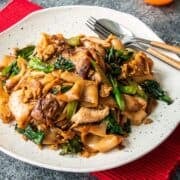
Authentic Thai Pad See Ew ผัดซีอิ้ว
- Prep Time: 20 min
- Cook Time: 10 min
- Total Time: 30 minutes
- Yield: 2 servings
Description
Chewy-tender fresh wide rice noodles are stir fried with a savory sauce and crunchy Chinese broccoli. There's a reason pad see ew is a cult favorite, and a personal favourite street food dish of mine!
Ingredients
Want to save this recipe?
Note: I recommend making 1 serving at a time to maximize noodle toasting, so you may want to split the ingredients in half when doing your prep. All the protein, however, can be cooked all together.
Marinated Meat
- 8 oz (225 g) protein of your choice, thinly sliced (see note 1)
- 2 tsp (10 ml) soy sauce for marinating meat, omit if using shrimp or tofu
- ¼ tsp (1 ml) sugar
Pad See Ew
- 3-4 tablespoon (45-60 ml)vegetable oil
- 4 cloves garlic, chopped
- 2 large eggs
- 4-6 stalks (150 g) Chinese broccoli, aka gai lan, stems thinly sliced on a bias, leaves roughly chopped
- 1 lb (450g) fresh wide rice noodles (ho fun noodles), store bought or make your own (see note 2)
- 4 tsp granulated sugar
- Ground white pepper, to taste
- Optional condiment but highly recommended: chili vinegar (prik nam som)
Sauce
- 2 Tbsp (30 ml) oyster sauce
- 1 Tbsp (15 ml) soy sauce
- 1 ½ tsp (7.5 ml) fish sauce
- 1 ½ tsp (7.5 ml) Golden Mountain sauce, or sub Maggi Seasoning
- 2 tsp (10 ml) Thai black soy sauce (see note 3)
For descriptions of all these sauces, see blog post above.
Instructions
- For the marinated meat: Mix together the meat, soy sauce, and sugar. If your meat is lean, such as chicken breast or pork loin, add about 2 teaspoons (10 ml) of water to make it a little juicier. Mix well.
- If noodles are stuck together, peel them apart into individual strands (if they're cold and hard see note 2). Divide noodles into individual portion as you will cook this one portion at a time (8 oz/225 g of noodles per portion).
- Combine all sauce ingredients together and stir to mix well, divide the sauce evenly into individual portions - each portion is 2 tablespoon + 1 teaspoon (35 ml)
- Heat 1 tablespoon (15 ml) of the oil in a well-seasoned wok or a large cast iron skillet over high heat (you want a well-seasoned pans as the noodles will stick otherwise). When hot, add all of the protein and spread them out into a single layer. Let the meat sear until browned on the underside, then toss until they're fully cooked. Remove from the pan and set aside.
- From this step onward, I recommend cooking 1 portion at a time for best result: In the same wok, with the heat still off, add 1½ tablespoon (22 ml) oil and 1 portion of the garlic and turn the heat on to medium-high; stir until the smallest bits of garlic starts to turn golden.
- Add the egg, break the yolk, let it set just about halfway, then scramble briefly.
- Add the Chinese broccoli and toss to coat it in the oil, about 10–15 seconds.
- Add 1 portion of rice noodles, 1 portion of the sauce mixture, and 2 teaspoon of sugar. Turn the heat up to high and toss to coat the noodles evenly in the sauce. Be aware not to let your spatula cut the noodles.
- Once coated, spread the noodles out to cover the entire pan and let them sit without stirring for about 15-30 seconds or until some of the noodles have charred. Flip or toss the noodles and let them sit again to char the other side. You may flip the noodles again a couple more times to get more toasting if you wish.
- Add 1 portion of the cooked protein back into the pan without adding any meat juices that has accumulated, and toss briefly to mix. Turn off the heat.
- Plate the noodles, then quickly wipe the pan clean with paper towel and cook the next serving.
- When serving, sprinkle with some ground white pepper and serve with chili vinegar. Enjoy!
Note: Cooking 1 portion at a time is a bit more work, but it is well worth it. If there are too many noodles piled in the wok, it'll trap a lot of steam which can overcook the noodles. It'll also prevent the noodles from charring, which adds an iconic toasty flavour.
Notes
- Beef, chicken, pork and shrimp are common protein options. If using tofu, I recommend using fried tofu or firm tofu which can hold up in the wok well. You can buy tofu already fried at Asian grocery stores or fry your own tofu until a golden brown crust forms.
- If your rice noodles come cold and stuck together, do not try to peel them apart cold. Divide them into smaller chunks best you can then spread them on a plate and microwave them for 1 minute. Divide them further, if possible, then microwave them again for another minute. Repeat the heating and separating until the noodles are hot and soft enough to be individually peeled apart.
- Black soy sauce adds a dark colour and rich flavour iconic to pad see ew. If not available, sub equal amount of Chinese dark soy sauce and omit the Golden Mountain Seasoning; this is because Chinese dark soy is much saltier than Thai black soy sauce so we need to reduce the saltiness elsewhere. If more saltiness is needed, you can always add a little more soy sauce or fish sauce at the table.


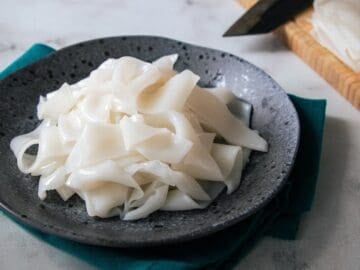
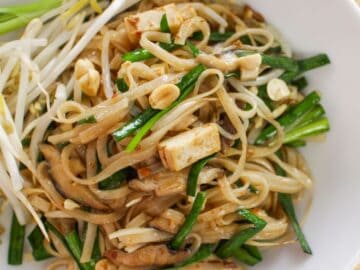
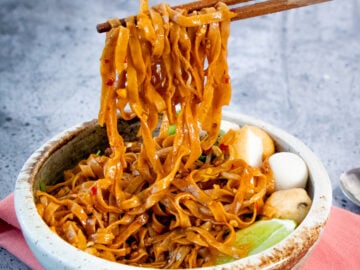
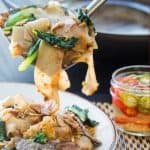
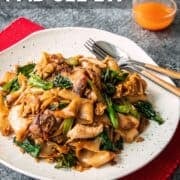
Sarah says
I was doubtful i could do this. I followed your recipe, it wasn't perfect, but omg, im on my way! It was still tasty. Thank you 😊
Katanahamon says
Get a kitchen torch..you can go over your stir fries and get that char quite quickly and easily.
Alex says
Do you know where I can get Thai dark soy sauce in the Vancouver area? Tried Hen Long and T&T, neither had it.
Colten Munyon says
Absolutely Amazing
Michael Morris says
This was SO good! I never knew about the chili vinegar sauce so I made that, too, and wow, what a delicious condiment for this dish!
Steve says
Is there a reason why we don't add the sugar to the sauce? Seems like it's easy to forget, as shown in the video, and I didn't see the step in the recipe where it gets added.
Hiroko says
I am Japanese living in USA, and my favorite Thai dish has always been pad see ew. I bought all the authentic Thai ingredients at an Asian market just to make this dish with your recipe, and it’s SO DELICIOUS. I’ve made it three times in one week so that I can share with my friends, and they all loved it. Thank you so much for sharing the amazing recipe, being able to cook Thai food at home was on my bucket list for a long time, now with all the Thai soy sauces I can try other recipes on your website! Love from Seattle .
Andree says
I made this dish last night with substitutions. I had leftover roasted chicken and used broccoli and spinach . I had ho fun in the freezer and it thawed just fine! Made the chili vinegar too, but not enough! This was so good! And something different to do with left over chicken! Thanks!
L.Reid says
DELICIOUS! The recipe and technique is flawless and you must do the vinegar, it is the perfect finish! I LOVE Hot Thai Kitchen, thank you for a wonderful meal!
PB Kelley says
Fantastic recipe. The work-arounds Pai provides are fantastic. We have substituted noodles and proteins and the recipe still turns out fantastic every time. The char and chew of the noodles makes the dish for me. Proteins are interchangeable as the noodles and sauce are the stars of the show.
Russ says
Awesome recipe, in my regular rotation. It's not something I typically order when I go out to a Thai restaurant but it's one of my favorites at home. Highly recommend! Haven't been able to track down fresh noodles yet (need to try her recipe for making those at home), but also great with store bought dry noodles.
Jen Walker says
Absolutely love this recipe! I’ve introduced my Son to my favorite Thai dish. Your cooking directions made this possible…
Karan says
Thank you so much for the tip on how to use dry rice noodles because I had dry rice flakes (think big and square), so after soaking I cut them in half and they were just fine. I had tried a similar recipe before and had awful trouble with the noodles, but following your directions I got a wonderful dinner of real Pad See Ew and my husband and I both agreed we could eat another serving each because it was so good.
Lisa says
“Fresh” means the ones that are already cooked in a package.
There’s a page on this website that specifies how to prepare the wide noodles by soaking, just FYI.
Anonymous says
Anonymous says
Kaj says
Thank you for this recipe, I’m looking forward to making it. I have a question, I am using tofu and have some black Chinese vinegar. Do you think I could add a small amount to the tofu for flavour and then add red chillies in at the end so I could skip the part with the chilli vinegar?
Pailin Chongchitnant says
You can just add chilies to the noodles, and use the vinegar as a condiment at the end. I wouldn't put the vinegar IN the noodles because it's meant to be added "to taste" as a condiment and it will be easy to overdo.
Thomas Wynn says
Thanks for this recipe!! Can you clarify, is the 6oz of protein and 4 to 6 stalks per serving or should they be split in 2 like the noodles?
Pailin Chongchitnant says
The protein doesn't need to be separated because you can cook it all at once, and you'll just add half back in for each batch. Everything else should be split.
Hannah says
Wow!!!! I am so grateful. this is restaurant quality! I cannot believe how amazing this turned out. I will say, I added a bit more brown sugar for my taste 1-2 tsp more. I plan to use less for my mom who likes it less sweet.
gergana shkodrova says
Thank you, thank you, this recipe is the best ever! It turned out great, even if I had to make do with what I have as supplies (problematic this corner of the earth) and utensils (likewise). Made me feel so nostalgic, too... Thailand, my love:))))
Brenbert says
i have spent 5 years trying to find the best pad see ew recipe.
this is the one.
i like using dried noodles and getting them al dente 🙌
Cindy says
I have a question. This was one of my favorite dishes for several years. Then suddenly the taste changed. Now the sauce tastes burnt to me. Is it supposed to taste that way? I've ordered it three times lately and it always tastes burnt and I don't care for that. I guess I need to try your recipe and see if I get the same result as the restaurant. I'd love to hear your feedback.
Paige says
Just my personal experience: Do other people note the same change in flavor? I just had a type of heath disorder that changes my taste (for now, I hope). Unwanted taste notes now can ruin my food, including burnt, mineral, and bitter. I'm sorry for your change in enjoyment.
Pailin Chongchitnant says
It can taste smokey, which might be what you're calling "burnt". But that depends on how it's made and homemade ones rarely has this smokiness. It happens when a restaurant uses a carbon steel wok over high heat. Just FYI that the smokiness is one of the traits of PSE that many people love and many cooks try to go for that. But I suppose it can be overdone, which might be your situation.